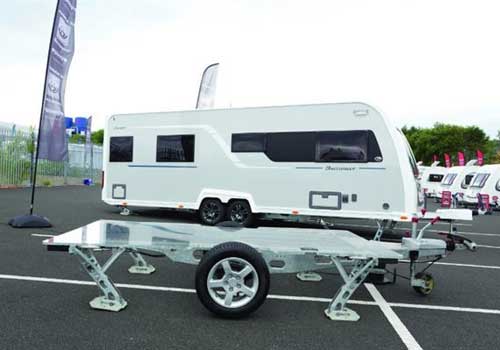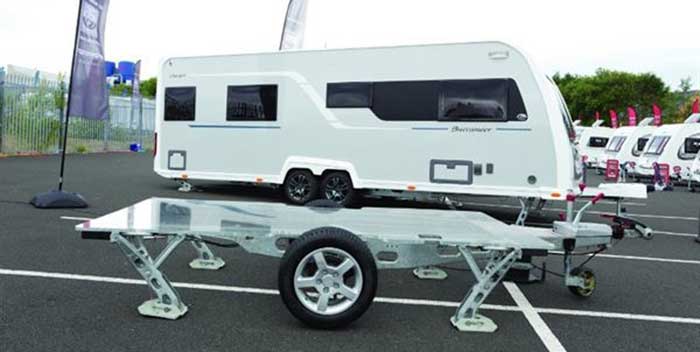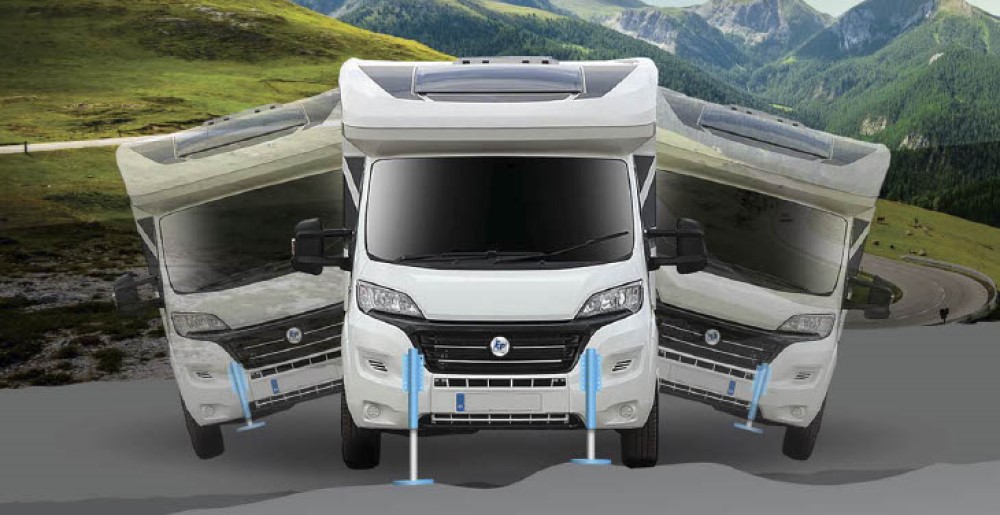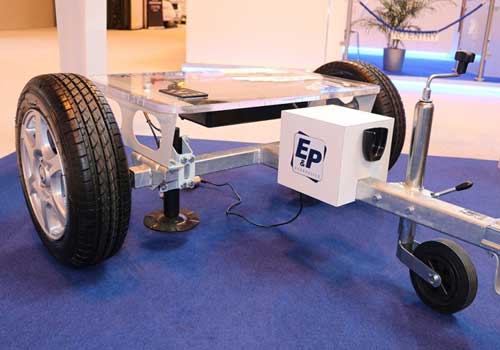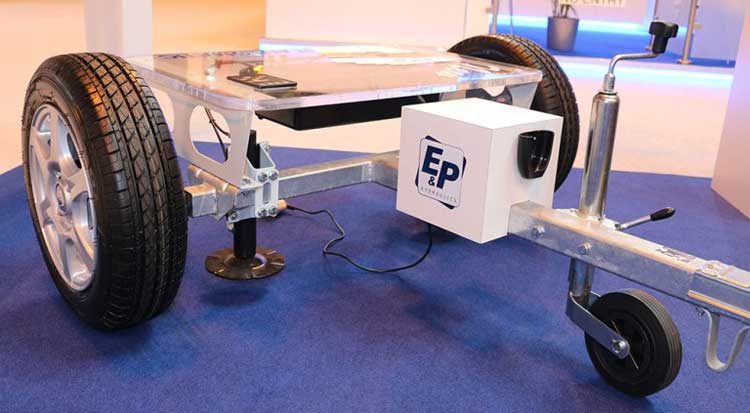The essential task of levelling a caravan has remained stubbornly low-tech for half a century, relying on wooden planks, or, at best, bespoke, but still basic, plastic levelling ramps.
But, all of a sudden, the 21st century arrived. The pace of change accelerated and engineers turned their attention to the boring and unsophisticated task of winding up and down four metal legs every time we pitch and break camp.
Even for those who choose to use a rechargeable drill to quicken the process, it’s still surely caravanning’s dullest task?
Along came automatic caravan levelling systems…
Then, in 2007, with a buzz and a whir, a company in Blackburn changed all that. Enter the E&P Levelsystem, which magically levels a caravan at the touch of a button. Suddenly, there was an alternative to winding a handle or getting out a drill (assuming you’ve remembered to recharge it!).
To begin with, E&P made levelling products that a specialist fitter would retrofit to your tourer. The process is pretty straightforward and takes just a day for the full system.
But then, the Explorer Group began offering the ‘elbow-grease-removing’ system as standard on its luxury Buccaneer caravans.
I clearly recall its public unveiling, at the Buccaneer factory in County Durham. E&P Hydraulics gave us a lesson in this new, luxury method of levelling.
They passed us a handset. At the touch of a button, a series of rhythmic motor sounds emerged from the axle area of the giant Buccaneer, as two substantial pistons, with big, flat bases, slowly descended.
Hydraulic legs
As the feet touched the ground, the big Bucc shifted and tilted on these hydraulic ‘legs’. Within a few seconds, the caravan was level from side to side, on the far-from-even ground.
Then, as if with a mind of its own, the system turned its attention to the front-to-back levelling. Four giant corner steadies descended, emitting metallic, whirring sounds. Within two minutes, a caravan that weighed just shy of 2000 kg, was level. Impressive.
Next, Lunar saw the labour-saving potential of Levelsystem and fitted it to its new brand of caravan, Alaria, launched last year. That brought the number of models with auto-levelling appeal as standard to eight.
Caravan magazine’s technical expert, Terry Owen, availed himself of this new advancement. He has a Levelsystem fitted to his Bessacarr 645 and says the ease of pitching firm and level is a brilliant asset to his enjoyment of caravanning.
And there’s now a cheaper, alternative option, too. E&P makes a cut-down version of the Complete Caravan Levelsystem, called Compact Caravan Levelsystem. Less cost. Less impact upon your payload. More appeal? Well, perhaps.
Unless your techie appetite means nothing less than the maximum amount of engineering, hydraulics and wizardry will do.
It’s good to have the option, though. This is why we decided to find out more. So Caravan magazine headed to Blackburn, and the headquarters of E&P…
How does Levelsystem work?
The brilliant thing is its simplicity: it has a hydraulic pump, an electric motor, two-axle jacks and four heavy-duty legs of E&P’s own design (fitted with AL-KO’s Big Footplates). When you start the system, the hydraulic pump engages and feeds the jacks with 170 bar of pressure to raise the caravan.
The right jack exerts the most pressure and comes down first, levelling the caravan side to side. Then the front legs come down to stabilise, followed by the left jack descending to finish the side-to-side levelling process.
Finally, the rear legs lower to make the final adjustments. All in under two minutes (I videoed the process in real-time and it took just 1 minute 27 seconds from the first whir to the final thunk).
Can Levelsystem be fitted to any caravan?
The levelling system can be fitted to any single or twin-axle caravan. The only difference is where you mount the axle jacks. On a single-axle they’re mounted behind the axle and on a twin, you mount them in between (forward of the rear axle).
What are the components?
The Complete kit comprises the two axle jacks, the hydraulic pump system, the electric motor, the CPU or ‘brain’, pressure switch, valve blocks and the pipework leading to the jacks and leg pistons.
What maintenance does it require?
The levelling system is fully sealed and self-contained (it’s a closed-loop system). It needs no topping up of fluid and the only maintenance required is a quick spray of silicone-based lubricant (WD40) on the axle jacks, and on the leg pistons to eliminate the possibility of corrosion.
Is there a maximum weight of caravan?
This is a simple but mighty piece of kit; the jacks are capable of lifting a remarkable three tonnes! That’s the heaviest caravan on the market, fully laden with eight people inside. Impressive.
How levelling controlled?
There’s a fixed control panel in the caravan, a remote handset, and for those wanting to have the ultimate in tech, there’s an app in the pipeline, too. Launching in 2018, the app will be compatible with existing levelling systems (a minor software upgrade will be needed, but will be compatible with all existing levellers).
How much does it weigh?
By this point, you’re probably thinking that all this hardware is going to add a bit of weight to your caravan and thereby drastically reduce your available payload. It’s not as heavy as you might think, though. The factory-fitted unit adds 28kg and the retro-fitted Compact kit only 20kg. While it does impact your payload, it’s only by a manageable amount.
How much does it cost?
The Complete system, with two axle jacks and four hydraulic levelling legs, costs £2957, including parts, labour and VAT. The Compact system, with just the two axle jacks, costs £1808.
Can Levelsystem be moved to a new caravan?
When you get around to changing your caravan, there’s no need to leave the leveller behind; switching/upgrading will cost around £1200.
How long does it take to fit?
Complete system – one day; Compact system – four hours, by one of the 15 authorised UK fitters.
What gradient is the system designed for?
Levelsystem operates on a gradient of up to 5%. And when the gradient is greater than 5%? As you would normally, on extreme undulating ground, you will need wooden blocks.
You then activate the manual mode to bring down individual legs until they hit the wood platform, then simply allow the unit to auto-level.
Are there any other benefits?
If your caravan is in storage, you can raise the wheels off the ground, so it just sits on the jacks for prolonged periods, to prevents tyre flat-spots.
Plus, when the jacks are down they constitute an extra security measure because the wheels are not in contact with the ground.
Power failure?
And finally, I ask what happens if the site’s 240V power fails and my battery runs flat with the jacks and legs down? (Or it’s been on a video shoot, and no one bothered to plug it in despite using the levelling system repeatedly all day (As once happened in our team!). It doesn’t use much power, but operate it 25-30 times, and it will drain the leisure battery.)
It turns out there is an emergency retract button. You simply connect the caravan 12-volt cable up to your car in the usual manner (as if you were hitching up) and press the button. This will bypass the leveller’s ‘brain’ and retract everything, meaning you won’t be stuck on a campsite with an immovable, if perfectly level, caravan.
For more information about E&P Hydraulics Level C caravan levelling system, CLICK HERE.
Source: Out and About Live.

